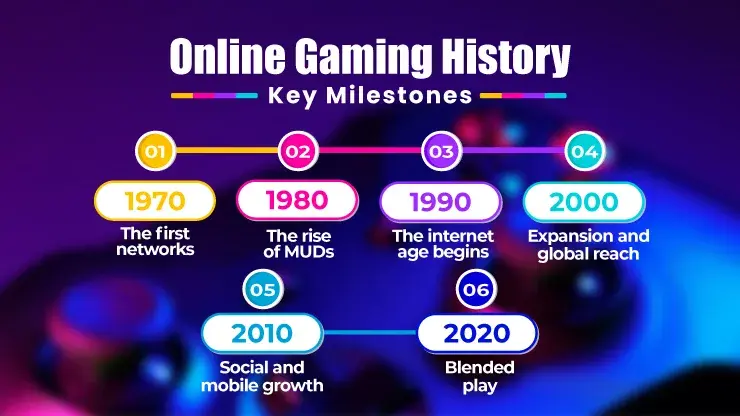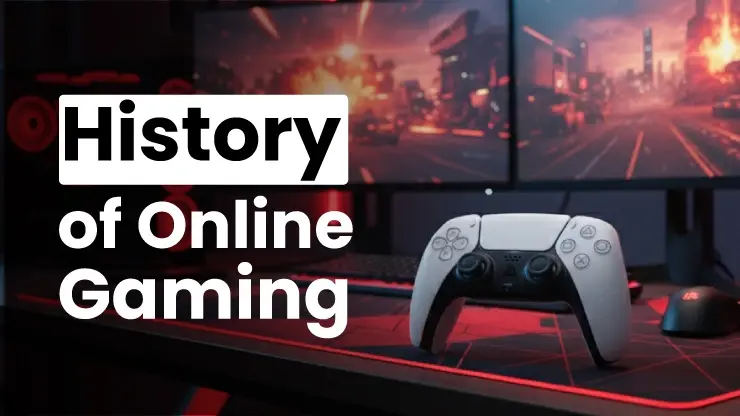The history of online gaming is a story of people finding ways to connect across distance. First through wires. Then through the web. Today through phones and consoles. The idea stayed the same: share a session with someone who is not in the room.
This story did not start with flashy graphics. It began with terminals, message boards, and simple text. Engineers and students linked machines. They tested networks. They tried early chat and multi-user worlds. Over time, better hardware and faster links made bigger experiences possible.
What followed was steady growth. Small communities formed. Then they scaled. New genres appeared. Teams built tools for finding matches and hosting sessions. Social features turned one-off sessions into habits and friendships.
This article traces that path from those first experiments to large platforms today. It explains how early systems set the foundation. It outlines the people and projects that pushed the medium forward. It highlights key moments, from text worlds to real-time 3D to mobile platforms where millions now compete and connect. And it closes with how this medium shaped culture, business, and technology.
Origins of Online Gaming
The origin of online gaming goes back to the 1960s and 70s, long before the internet became public. Computers were large and expensive, used mostly in universities and research labs. But people were already experimenting with how two or more users could share a single system to compete or collaborate.
One of the earliest examples came from the PLATO system at the University of Illinois. It connected terminals to a central computer, allowing students to log in together. PLATO featured text chat, message boards, and even early multiplayer titles like Empire and Spasim. These were simple, but they introduced ideas that shaped everything later—shared space, real-time updates, and user identity.
Around the same time, ARPANET—the network that later became the internet was used by programmers to connect distant computers. Researchers began sending basic text commands between machines. This led to the first networked multiplayer experiments, including early versions of strategy and adventure games that could be played remotely.
In the late 1970s and early 80s, Multi-User Dungeons (MUDs) appeared. These were text-based worlds where multiple people explored, battled, and chatted at once. MUD1, created in 1978 by Roy Trubshaw and Richard Bartle at the University of Essex, is often cited as a key step in online games invention. It introduced persistent virtual spaces where actions by one user affected everyone else—a concept still central to multiplayer design today.
As home computers spread in the 80s, more people gained access to dial-up connections. Bulletin Board Systems (BBS) allowed small communities to share files and messages, and even host tiny competitive sessions. While slow and limited, these setups kept the social spirit alive.
Together, PLATO, ARPANET, and MUDs mark the first generation of digital community experiences. They proved that people didn’t need to be in the same room to share the same world. Those experiments set the foundation for everything that came after—from LAN matches to modern mobile apps.
How & Who Invented Online Games?
When people ask who invented online games, the answer isn’t one person or one moment. It was a chain of small steps across decades. Each new idea built on the last.
Early network engineers connected mainframes for experiments. Students then used those same systems for fun. That mix of technology and curiosity shaped what came next.
The inventor of online games can’t be named as a single figure. But certain names always appear in the story. Roy Trubshaw and Richard Bartle, creators of MUD1 in 1978, shaped how virtual spaces worked. They showed that a shared world could exist purely through text. Around the same time, programmers on ARPANET linked machines to compete in basic simulations. These were small projects, but they proved that remote interaction was possible.
The question when were online games invented has no single date either. But the late 1970s were key. That’s when systems like PLATO and MUDs became active and attracted regular users. People logged in not just to test code but to meet others. It was the start of networked leisure.
So, who made online games? It was teams of researchers, hobbyists, and students working in universities and labs. Their goal wasn’t to sell anything. They wanted to see how computers could connect people. Those projects later inspired studios and developers who turned experiments into full products.
As for online games were invented in which country, most early work came from the United States and the United Kingdom. PLATO began in Illinois. MUD1 started at the University of Essex. These two lines of work—academic and creative—ran side by side and shaped the future.
This was also the period of online gaming origin. It combined science, art, and human curiosity. Over time, that spirit spread across continents as modems and home computers became affordable. What began as text and numbers slowly grew into visual worlds.
In short, the online games invention was not a single event. It was a gradual build made possible by many minds. The result was a new form of connection that changed how people interacted, learned, and relaxed.
Evolution of Multiplayer Gaming in the 2000s
The early 2000s marked a turning point in how people connected through interactive worlds. Better internet access, faster computers, and affordable consoles made shared experiences easy to reach. What started in labs and universities became part of everyday life.
This period defined the evolution of online gaming. Local connections moved to global networks. Players could now join matches with strangers across continents. Titles like Counter-Strike, World of Warcraft, and Runescape made this shift visible. These weren’t just digital games; they were communities with their own cultures, rules, and economies.
Matchmaking systems, chat tools, and leaderboards created structure. People could compete, cooperate, or just hang out. Forums and voice channels added a social layer that made sessions personal. Even mobile phones soon joined in, shrinking the distance between users.
As broadband grew, casual formats took off too. Not everyone wanted long missions or complex gear. Some just wanted short, quick sessions. That’s where lighter titles like free Ludo games gained traction. They mixed simplicity with connection. Platforms like Zupee helped bring that spirit to mobile, offering short, skill based games that mirrored the friendly rivalry once found around kitchen tables.
The 2000s proved that shared interaction could fit every device and every mood. Whether through massive online worlds or fast mobile matches, it showed that connection, not hardware, was the heart of modern entertainment.
Key Milestones in the History of Online Games
The history of online games is full of small steps that changed how people connect. Each step built on the last. Together, they shaped what we now call multiplayer.
Here’s a quick timeline of that journey:

- 1970s – The first networks: ARPANET linked computers in the U.S. Students tested text-based sessions. PLATO systems added shared screens and early chat.
- 1980s – The rise of MUDs: Multi-User Dungeons brought people into shared virtual worlds. These text spaces became the base for later role-playing titles.
- 1990s – The internet age begins: Faster modems let home users join servers. Doom and Quake showed what real-time battles felt like. Online sessions became social events.
- 2000s – Expansion and global reach: Broadband made connection easy. Consoles joined in. World of Warcraft and Counter-Strike turned remote sessions into daily habits.
- 2010s – Social and mobile growth: Phones carried the experience everywhere. Titles like Clash of Clans and quick casual apps reached millions.
- 2020s – Blended play: Now, devices and platforms mix. People shift from PC to phone without losing progress. Visuals are realistic. Matches are instant.
Each milestone shows how a simple idea, connecting people through interaction, grew into something huge. It also shows how online gaming history is still being written. The tools keep changing, but the goal stays the same: shared fun, no matter the distance.
Impact of Online Games on Society
The growth of connected experiences changed how people spend time, learn, and interact. What started as small experiments now shapes global culture.
1. Social Connectivity and Communities
Shared digital spaces made new kinds of friendship possible. People met through sessions, chats, and forums. Some stayed connected for years without meeting in person. From early MUD chatrooms to modern voice servers, these spaces built trust and teamwork. Communities also became creative hubs. Fans made guides, mods, and art. The online gaming history shows how social bonds formed even before video calls or social media existed.
2. Economic Impact
Large studios, small developers, and even independent creators built steady work from interactive platforms. A full market formed around accessories, streaming, and tournaments.
It isn’t just entertainment now. It’s part of digital economies. Jobs grew in design, testing, and content creation.
3. Development of Esports and Competitive Gaming
Competitive events changed how people viewed interactive sessions. Players became professionals. Teams formed. Sponsors joined in. The first local competitions were small. But over time, they filled arenas and streamed worldwide. This rise also pushed better design, balance, and fairness.
4. Technological Advancements
Interactive technology often drives hardware and software progress. Graphics cards, servers, and broadband all improved to meet user demand. Cross-platform tools and cloud systems came next. They allow users to switch between devices with ease.
Even short fun games benefit from these updates. Smaller formats, including quick skill-based apps, use these same systems. They connect people who prefer short sessions over long missions. Platforms like Zupee show how far this idea has come. People can join, compete, and interact in a few minutes without complex gear or setup. The creativity that began with those who asked who invented online games continues to drive new ideas even today.
These changes show how broad the impact is. The types of online games may differ, but the effect is shared: connection, progress, and new ways to experience community.
The History of Online Gaming and Its Ongoing Journey
The history of online gaming is a reminder that progress often starts small. What began as short text exchanges between two computers turned into a global way to connect. Each era added a new piece—networks, visuals, speed, and social features.
The history of online games reflects human curiosity more than technology. People wanted to talk, compete, and share moments through screens. That same curiosity drives new formats today, from massive open worlds to quick mobile matches.
Across decades, developers built tools that shaped communication, teamwork, and creativity. The growth of interactive platforms also created jobs, communities, and even new forms of learning.
And yet, online gaming history is not done. Every update and every new platform adds another line to the story. What started as a small experiment now connects millions across borders. The idea that once lived on lab computers has become a part of everyday life.

